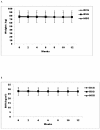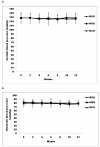Effects of pistachios on body weight in Chinese subjects with metabolic syndrome
- PMID: 22472037
- PMCID: PMC3383470
- DOI: 10.1186/1475-2891-11-20
Effects of pistachios on body weight in Chinese subjects with metabolic syndrome
Abstract
Background: Studies have shown that pistachios can improve blood lipid profiles in subjects with moderate hypercholesterolemia which could reduce the risk of cardiovascular disease. However, there is also a widely perceived view that eating nuts can lead to body weight gain due to their high fat content.
Purpose: To investigate the impact of different dosages of pistachios on body weight, blood pressure, blood lipids, blood glucose and insulin in subjects with metabolic syndrome.
Methods: Ninety subjects with metabolic syndrome (consistent with 2005 International Diabetes Federation metabolic syndrome standard without diabetes) were enrolled in three endocrinology outpatient clinics in Beijing. All subjects received dietary counseling according to the guidelines of the American Heart Association Step I diet. After a 4 week run-in, subjects were randomized to consume either the recommended daily serving of 42 g pistachios (RSG), a higher daily serving of 70 g pistachio (HSG) or no pistachios (DCG) for 12 weeks.
Results: Subjects in all three groups were matched at baseline for BMI: DCG 28.03 ± 4.3; RSG 28.12 ± 3.22; and HSG 28.01 ± 4.51 kg/m2. There were no significant changes in body weight or BMI in any groups during the study nor any change from baseline at any time point in any group. During the entire study, there were no significant differences in waist-to-hip ratio among the groups or any change from baseline in any group (DCG -0.00 ± 0.03, RSG -0.01 ± 0.02 and HSG 0.01 ± 0.04). There were no significant differences detected among groups in triglycerides, fasting glucose and 2 hour postprandial glucose following a 75 gram glucose challenge. Exploratory analyses demonstrated that glucose values 2 h after a 75 gm glucose challenge were significantly lower at week 12 compared with baseline values in the HSG group (-1.13 ± 2.58 mmol/L, p = 0.02), and a similar trend was noted in the RSG group (-0.77 ± 2.07 mmol/L, p = 0.06), while no significant change was seen in the DCG group (-0.15 ± 2.27 mmol/L, p = 0.530). At the end of study, serum triglyceride levels were significantly lower compared with baseline in the RSG group (-0.38 ± 0.79 mmol/L, p = 0.018), but no significant changes were observed in the HSG or DCG groups.
Conclusion: Despite concerns that pistachio nut consumption may promote weight gain, the daily ingestion of either 42 g or 70 g of pistachios for 12 weeks did not lead to weight gain or an increase in waist-to-hip ratio in Chinese subjects with metabolic syndrome. In addition, pistachio consumption may improve the risk factor associated with the metabolic syndrome.
Figures



Similar articles
-
Effects of pistachio nuts on body composition, metabolic, inflammatory and oxidative stress parameters in Asian Indians with metabolic syndrome: a 24-wk, randomized control trial.Nutrition. 2014 Feb;30(2):192-7. doi: 10.1016/j.nut.2013.08.005. Nutrition. 2014. PMID: 24377454 Clinical Trial.
-
Effects of pistachios on the lipid/lipoprotein profile, glycemic control, inflammation, and endothelial function in type 2 diabetes: A randomized trial.Metabolism. 2015 Nov;64(11):1521-9. doi: 10.1016/j.metabol.2015.07.021. Epub 2015 Jul 30. Metabolism. 2015. PMID: 26383493 Free PMC article. Clinical Trial.
-
Acute effects of pistachio consumption on glucose and insulin, satiety hormones and endothelial function in the metabolic syndrome.Eur J Clin Nutr. 2014 Mar;68(3):370-5. doi: 10.1038/ejcn.2013.275. Epub 2014 Jan 15. Eur J Clin Nutr. 2014. PMID: 24424074 Clinical Trial.
-
Pistachio nuts: composition and potential health benefits.Nutr Rev. 2012 Apr;70(4):234-40. doi: 10.1111/j.1753-4887.2011.00467.x. Nutr Rev. 2012. PMID: 22458696 Review.
-
Health benefits of pistachios consumption.Nat Prod Res. 2019 Mar;33(5):715-726. doi: 10.1080/14786419.2017.1408093. Epub 2017 Dec 15. Nat Prod Res. 2019. PMID: 29241364 Review.
Cited by
-
Effects of Pistachio Consumption in a Behavioral Weight Loss Intervention on Weight Change, Cardiometabolic Factors, and Dietary Intake.Nutrients. 2020 Jul 20;12(7):2155. doi: 10.3390/nu12072155. Nutrients. 2020. PMID: 32698457 Free PMC article. Clinical Trial.
-
Benefits of Nut Consumption on Insulin Resistance and Cardiovascular Risk Factors: Multiple Potential Mechanisms of Actions.Nutrients. 2017 Nov 22;9(11):1271. doi: 10.3390/nu9111271. Nutrients. 2017. PMID: 29165404 Free PMC article. Review.
-
Protocol for a randomized controlled trial to test the acceptability and adherence to 6-months of walnut supplementation in Chinese adults at high risk of cardiovascular disease.Nutr J. 2021 Jan 6;20(1):3. doi: 10.1186/s12937-020-00660-7. Nutr J. 2021. PMID: 33407490 Free PMC article.
-
Effect of tree nuts on metabolic syndrome criteria: a systematic review and meta-analysis of randomised controlled trials.BMJ Open. 2014 Jul 29;4(7):e004660. doi: 10.1136/bmjopen-2013-004660. BMJ Open. 2014. PMID: 25074070 Free PMC article.
-
Nuts and seeds consumption and risk of cardiovascular disease, type 2 diabetes and their risk factors: a systematic review and meta-analysis.Food Nutr Res. 2023 Feb 14;67. doi: 10.29219/fnr.v67.8961. eCollection 2023. Food Nutr Res. 2023. PMID: 36816545 Free PMC article. Review.
References
-
- Gebauer SK, West SG, Kay CD, Alaupovic P, Bagshaw D, Kris-Etherton PM. Effects of pistachios on cardiovascular disease risk factors and potential mechanisms of action: a dose-response study. Am J Clin Nutr. 2008;88:651–659. - PubMed
-
- Kris-Etherton PM, Hu FB, Ros E, Sabate J. The role of tree nuts and peanuts in the prevention of coronary heart disease: multiple potential mechanisms. J Nutr. 2008;138:1746S–1751S. - PubMed

